If you like fried rice, you must not miss the Indonesian and Malay versions called nasi goreng.
What is nasi goreng?
Nasi goreng means fried rice in Indonesian language and also in Malay language. It is cooked with a chili paste consisting of bird’s-eye chili, shallot, garlic, belacan (a local shrimp paste), and anchovies. It is the most beloved fried rice in Southeast Asia.
This article will explain how to prepare the nasi goreng famous in Malaysia called nasi goreng kampung (village fried rice). The taste of this nasi goreng is entirely different from other Asian and Chinese fried rice, using chili paste, kangkung (water spinach or
If you like fried rice, you must not miss the Indonesian and Malay versions called nasi goreng.
What is nasi goreng?
Nasi goreng means fried rice in Indonesian language and also in Malay language. It is cooked with a chili paste consisting of bird’s-eye chili, shallot, garlic, belacan (a local shrimp paste), and anchovies. It is the most beloved fried rice in Southeast Asia.
This article will explain how to prepare the nasi goreng famous in Malaysia called nasi goreng kampung (village fried rice). The taste of this nasi goreng is entirely different from other Asian and Chinese fried rice, using chili paste, kangkung (water spinach or water convolvulus)), and ikan bilis (anchovies).
It is a drool-worthy, spicy gem of Indonesian cuisine.
Let’s dive into the details right away.
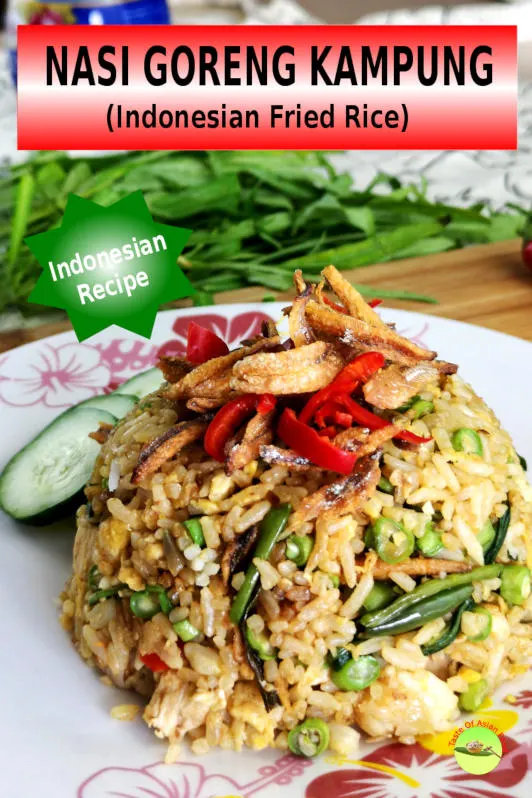
Note: This post may contain affiliate links. Please read my privacy policy for more info. I may receive commissions for purchases made through links in this post. As an Amazon Associate, I earn from qualifying purchases.
How to prepare nasi goreng kampung
1. Prepare the chili paste
The component of the chili paste
Chili paste is the essential component of nasi goreng. It is the combination of chili, shallot, and garlic, with other secondary ingredients such as shrimp paste (belacan) and tamarind juice (asam java). Let’s take a look at these ingredients one by one.
Chili
The most common type of chili for making the paste is the bird’s-eye chili (chili api). It is a small chili about two inches long, and comes with red and green color. The word ‘api’ means fire, which implies it is fiercely hot. It measures around 50,000 – 100,000 Scoville heat units, which is much hotter than the jalapeño.
An alternative is the serrano chili, which is not as hot as the bird’s-eye chili. Some recipes use a combination of serrano chili, bird’s-eye chili, and dried red peppers. If you manage to find these ingredients, you are in for making an authentic nasi goreng. If not, the closest substitutes are cayenne pepper and chili flakes.
Shallot and onion
Both shallot and onion can be used to make the chili paste. Onion is the choice of the restaurant because of the cost factor, and the ease of preparation. Onion is bigger than shallot and therefore takes less time to peel and cut, which is significant for restaurants to save time and wages.
Shallot is more suitable to grind with the mortar and pestle, but onions are more convenient if you use a food processor to blend the ingredients.
Others
Garlic, belacan, and tamarind juice. The three essential elements for the chili paste are chili, onion/shallot, and garlic, while belacan and tamarind juice are optional.
Belacan is a type of local fermented shrimp paste. It has strong umami and should only require a small amount. It is also an ingredient to prepare the Malaysian satay sauce and is used in a considerable amount to stir-fry kangkung. Belacan has a unique flavor and smell (quite pungent in fact) and has no substitute. You can omit it if unavailable but highly recommended to include a small amount to boost the flavor.
Tamarind is another item for some nasi goreng kampung recipes. It is prepared by soaking the pulp of the tamarind in hot water. The tamarind extract has a sour note. Since some people might not prefer the presence of the sourness, so it is also an optional item.
The use of blender versus mortar and pestle to prepare the chili paste
Some cooks prefer using mortar and pestle to prepare the chile paste instead of being processed with a blender. They think that nasi goreng kampung is a village recipe that should be made manually. The argument also arises because the paste process by the blender is much finer than those grounded manually, which does not produce the same texture as the authentic recipe.
Since it is so convenient to use an electric blender in the modern kitchen, I decided to compare the results by using both methods to make the chili paste. Then I cooked two plates of nasi goreng, and tasted the subtle difference between the two versions.
I also let some Indonesian try and I got the approval for both versions from them. I think both are excellent, but I prefer to use mortar and pestle when I prepare a small quantity. It may sound more tedious to do it manually, but in fact, it saves time because I do not need to clean up the food processor.
2. How to make crispy fried anchovies
Ikan bills (anchovy ) is the critical ingredient in making nasi goreng. It is for preparing the chili paste, and for the topping for the fried rice.
The anchovies should be deep-fried until crispy. It does require some simple techniques to achieve the best result.
Here are the steps.
- Discard the head and gills. I know many people do not do that, even those who work in the restaurant. It is tedious and may deem unnecessary. However, it will not take too much time for the amount required for home cooks. The result is certainly more elegant and presentable.
- Rinse with water. Since ikan bilis is dried seafood, it is potentially contaminated with foreign matters, mainly sand. I understand that some cooks prefer not to wash it because they want to keep it dry to produce crispy and crunchy anchovies. I can understand this reasoning in the restaurant setting. However, I would prefer to rinse it when I cook it at home.
- After cleaning the anchovies, drain in a colander and then pat dry with a paper towel. Transfer it to another dry paper towel and spread it into a single layer. Set aside until it is thoroughly dry before frying.
- Fill the wok with cooking oil, about 1/4 inch deep. Corn oil, peanut oil, palm oil or any cooking oil with a neutral flavor and with a high smoking point are suitable for frying the anchovies. Olive oil is not ideal as it has its flavor, which makes the fried anchovies inauthentic.
- Put the anchovies into the hot oil, around 190°C/375°F. Keep stirring the anchovies with a pair of chopsticks.
- It takes about one minute to crisp up the anchovies. The exact duration depends on the temperature of the oil and the dryness of the anchovies. You can remove the anchovies when the oil stops sizzling and bubbling.
- Remove the anchovies and cool on a kitchen towel to absorb the excess oil. You can make a bigger batch and keep it in an airtight container for future use.
3. Can I use other vegetables instead of kangkung?
Kangkung is the indispensable ingredient for a truly authentic nasi goreng kampung, Malaysian style. However, there are instances when you want to use other vegetables. If you are not a fan of kangkung, or it is unavailable, you can substitute it with other leafy vegetables. My suggestion is to use the choy sum, which is a common vegetable in Asia.
Another popular ingredient for making nasi goreng kampung is the long bean. Cut the long bean into short sections and stir-fry together with the rice.
4. How to prepare cooked rice?
I have written a detailed article “How to cook the best restaurant-style fried rice.” on how to prepare the cooked rice, especially for making fried rice. The information is written for Chinese fried rice, but it is equally useful for Nasi Goreng Kampung.
If you want to skip the above article, here is the summary :
- Use overnight cooked rice. It is less sticky and easier to manage.
- If you want to cook some fresh rice specifically to prepare nasi goreng, you can use less water for cooking so that it turns out the dryer. It is easier to prepare fried rice with cooked rice that is slightly dry.
- You can spread the cooked rice thinly on a tray and blow it under the fan to make the rice dryer.
- Separate the rice grains with your clean hand before frying if it clumps together.
5. A detailed explanation of the stir-frying process
Once you have fried the anchovies and prepared the chili paste, the nasi goreng kampung can be done in five minutes.
Before adding the rice
- Heat some cooking oil in the wok. You can make use of the leftover oil after deep-frying the anchovies to infuse more flavor to the nasi goreng.
- Add the chili paste to the hot oil. Saute over low heat until it becomes aromatic.
- Add the meat of your choice. I use diced chicken breast meat in this recipe, but you can use other meat or include shrimp if you like. Stir-fry over low heat initially, then turn to medium heat when the chicken starts to cook through.
- Now you have the choice to remove the chicken and chili paste from the wok or add the cooked rice and eggs directly and continue stir-frying. I prefer to remove them from the wok, then stir-fry the cooked rice separately. This method may not be the textbook method, but the rice grains will have direct contact with the surface of the hot wok and brings out the aroma. It also dries up the surface of the rice grains and prevents them from clumping together and sticking onto the wok. Good fry rice should not be lumpy. Each rice grain should be separated and free flow.
After adding the rice
- Pour the rice into the wok with some oil after removing the chicken and chili paste. Stir fry over low heat initially. As the surface of the rice starts to dry up, it will become less sticky. Now you can increase the heat gradually to medium or even high without worrying the rice will stick to the wok. (Of course, there is no worry if you use a non-stick pan!).
- Push the rice to the side of the wok. Add two eggs and scramble it until half cooked. You may need to reduce the heat or add some oil should it starts to stick to the wok. Once the eggs are half cooked, push the rice back to the center to combine with the egg.
- Return the chili paste and chicken. Add the long bean and kangkong. Season with sweet soy sauce (kecap manis) , sugar, salt, and pepper.
- Keep stir-frying while increasing the heat to high. Stir fry until the kangkung are wilted.
- Add some spring onions as a garnish, which is optional.
- Dish out. Place a large tablespoon of fried anchovies on top and serve with prawn crackers (keropok), and a fried egg.
What if I do not have a high-power stove?
Not everyone has the luxury to own a high-power stove at home, just like in a restaurant. You can make the following adjustment to get a similar result if you are using a small stove.
- Cook in small batches. Stir-frying one serving at a time is the best way to keep the wok or pan hot throughout the entire cooking process.
- Use a large frying pan to replace the wok if you do not have one. It will not affect the result.
- Make sure the pan/wok is hot enough before adding the rice.
Conclusion
Nasi goreng is also referred to as Indonesian fried rice. It is particularly popular in South East Asia as many people living here like spicy food. Its popularity is also due to its unique flavor strikingly different from any form of Chinese fried rice.
If you are fond of eating fried rice, you may also want to try the famous Chinese fried rice – Yang Chow fried rice.
If you like Indonesian food, you should not miss the Indonesian rendang Minang.

Nasi goreng kampung
The perfect nasi goreng kampung with chili paste, kangkung, and anchovies. Easy and delicious Indonesian fried rice recipe.
Ingredients
Ingredients for paste (A)
- 4 cloves garlic
- 1 tbsp fried anchovies
- 10g (0.3 oz) of belacan
- 6 bird’s eye chili (red and green mix)
- 4 shallots, about 40g
Other ingredients (B)
- Cooking oil
- 60g (2 oz) Kangkong (water spinach)
- 50g (1.75 oz) long beans
- 10g (0.3 oz) ikan bilis (about one handful)
- 100g (3 oz) chicken breast meat 60g, cut into dice
- 2 egg
- 300g (10 oz) cooked rice
Seasoning (C)
- 2 tbsp kicap manis (Indonesian sweet soy sauce)
- 1/4 tsp ground white pepper
- 1 tsp sugar
- 1 tsp salt
Instructions
- Remove the head and gill of the anchovies. Rince. Drain. Dry on kitchen towel Fill the pan/wok with 1/4 of cooking oil. Deep-fried the dried anchovies in hot oil until crispy.
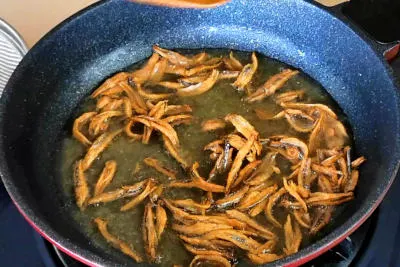
- Put on a kitchen towel to remove excess oil. Set aside or keep for future use.
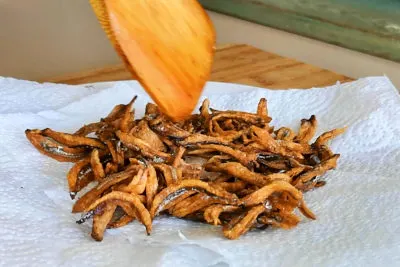
- Blend ingredient A. Then saute in the remaining oil after deep-frying the anchovies.
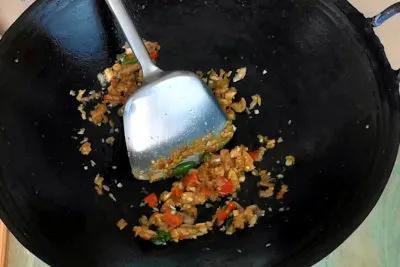
- Add the chicken cubes. Stir-fried over medium heat until the chicken is cooked. Remove from the wok.
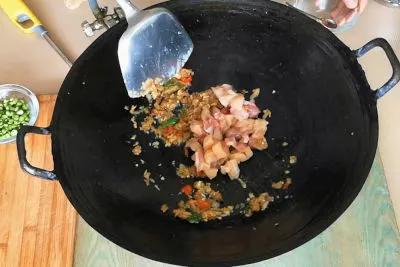
- Add some oil to stir-fry the cooled and dried cooked rice over low to medium heat for one minute. Push the rice to the side of the wok. Add two eggs. Scrambled the eggs until it is nearly cooked. Then push the rice back to the center and combine with the eggs.
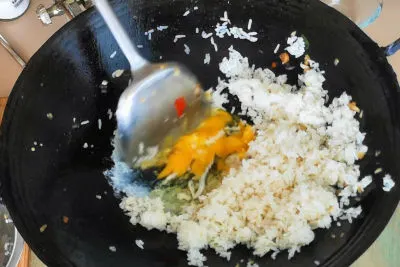
- Return the chili paste and chicken to the wok.
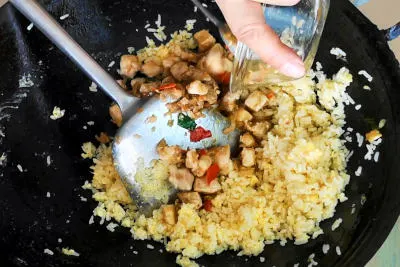
- Add the long beans and kangkung.
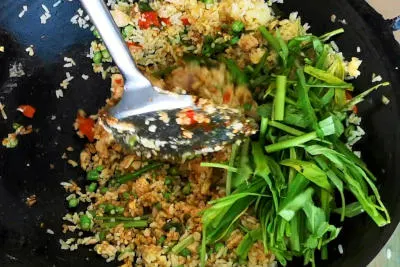
- Season with C.
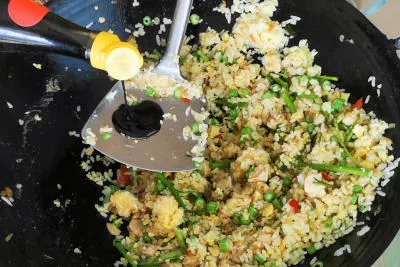
- Turn to high heat to stir fry for half a minute.

- Garnish and serve.

Recommended Products
As an Amazon Associate and member of other affiliate programs, I earn from qualifying purchases.
Nutrition Information:
Yield: 2 Serving Size: 1Amount Per Serving: Calories: 2208Total Fat: 117gSaturated Fat: 35gTrans Fat: 0gUnsaturated Fat: 54gCholesterol: 525mgSodium: 7487mgCarbohydrates: 155gFiber: 12gSugar: 27gProtein: 135g
This data was provided and calculated by Nutritionix on 4/30/2020
), and ikan bilis (anchovies).
It is a drool-worthy, spicy gem of Indonesian cuisine.
Let’s dive into the details right away.

Note: This post may contain affiliate links. Please read my privacy policy for more info. I may receive commissions for purchases made through links in this post. As an Amazon Associate, I earn from qualifying purchases.
How to prepare nasi goreng kampung
1. Prepare the chili paste
The component of the chili paste
Chili paste is the essential component of nasi goreng. It is the combination of chili, shallot, and garlic, with other secondary ingredients such as shrimp paste (belacan) and tamarind juice (asam java). Let’s take a look at these ingredients one by one.
Chili
The most common type of chili for making the paste is the bird’s-eye chili (chili api). It is a small chili about two inches long, and comes with red and green color. The word ‘api’ means fire, which implies it is fiercely hot. It measures around 50,000 – 100,000 Scoville heat units, which is much hotter than the jalapeño.
An alternative is the serrano chili, which is not as hot as the bird’s-eye chili. Some recipes use a combination of serrano chili, bird’s-eye chili, and dried red peppers. If you manage to find these ingredients, you are in for making an authentic nasi goreng. If not, the closest substitutes are cayenne pepper and chili flakes.
Shallot and onion
Both shallot and onion can be used to make the chili paste. Onion is the choice of the restaurant because of the cost factor, and the ease of preparation. Onion is bigger than shallot and therefore takes less time to peel and cut, which is significant for restaurants to save time and wages.
Shallot is more suitable to grind with the mortar and pestle, but onions are more convenient if you use a food processor to blend the ingredients.
Others
Garlic, belacan, and tamarind juice. The three essential elements for the chili paste are chili, onion/shallot, and garlic, while belacan and tamarind juice are optional.
Belacan is a type of local fermented shrimp paste. It has strong umami and should only require a small amount. It is also an ingredient to prepare the Malaysian satay sauce and is used in a considerable amount to stir-fry kangkung. Belacan has a unique flavor and smell (quite pungent in fact) and has no substitute. You can omit it if unavailable but highly recommended to include a small amount to boost the flavor.
Tamarind is another item for some nasi goreng kampung recipes. It is prepared by soaking the pulp of the tamarind in hot water. The tamarind extract has a sour note. Since some people might not prefer the presence of the sourness, so it is also an optional item.
The use of blender versus mortar and pestle to prepare the chili paste
Some cooks prefer using mortar and pestle to prepare the chile paste instead of being processed with a blender. They think that nasi goreng kampung is a village recipe that should be made manually. The argument also arises because the paste process by the blender is much finer than those grounded manually, which does not produce the same texture as the authentic recipe.
Since it is so convenient to use an electric blender in the modern kitchen, I decided to compare the results by using both methods to make the chili paste. Then I cooked two plates of nasi goreng, and tasted the subtle difference between the two versions.
I also let some Indonesian try and I got the approval for both versions from them. I think both are excellent, but I prefer to use mortar and pestle when I prepare a small quantity. It may sound more tedious to do it manually, but in fact, it saves time because I do not need to clean up the food processor.
2. How to make crispy fried anchovies
Ikan bills (anchovy ) is the critical ingredient in making nasi goreng. It is for preparing the chili paste, and for the topping for the fried rice.
The anchovies should be deep-fried until crispy. It does require some simple techniques to achieve the best result.
Here are the steps.
- Discard the head and gills. I know many people do not do that, even those who work in the restaurant. It is tedious and may deem unnecessary. However, it will not take too much time for the amount required for home cooks. The result is certainly more elegant and presentable.
- Rinse with water. Since ikan bilis is dried seafood, it is potentially contaminated with foreign matters, mainly sand. I understand that some cooks prefer not to wash it because they want to keep it dry to produce crispy and crunchy anchovies. I can understand this reasoning in the restaurant setting. However, I would prefer to rinse it when I cook it at home.
- After cleaning the anchovies, drain in a colander and then pat dry with a paper towel. Transfer it to another dry paper towel and spread it into a single layer. Set aside until it is thoroughly dry before frying.
- Fill the wok with cooking oil, about 1/4 inch deep. Corn oil, peanut oil, palm oil or any cooking oil with a neutral flavor and with a high smoking point are suitable for frying the anchovies. Olive oil is not ideal as it has its flavor, which makes the fried anchovies inauthentic.
- Put the anchovies into the hot oil, around 190°C/375°F. Keep stirring the anchovies with a pair of chopsticks.
- It takes about one minute to crisp up the anchovies. The exact duration depends on the temperature of the oil and the dryness of the anchovies. You can remove the anchovies when the oil stops sizzling and bubbling.
- Remove the anchovies and cool on a kitchen towel to absorb the excess oil. You can make a bigger batch and keep it in an airtight container for future use.
3. Can I use other vegetables instead of kangkung?
Kangkung is the indispensable ingredient for a truly authentic nasi goreng kampung, Malaysian style. However, there are instances when you want to use other vegetables. If you are not a fan of kangkung, or it is unavailable, you can substitute it with other leafy vegetables. My suggestion is to use the choy sum, which is a common vegetable in Asia.
Another popular ingredient for making nasi goreng kampung is the long bean. Cut the long bean into short sections and stir-fry together with the rice.
4. How to prepare cooked rice?
I have written a detailed article “How to cook the best restaurant-style fried rice.” on how to prepare the cooked rice, especially for making fried rice. The information is written for Chinese fried rice, but it is equally useful for Nasi Goreng Kampung.
If you want to skip the above article, here is the summary :
- Use overnight cooked rice. It is less sticky and easier to manage.
- If you want to cook some fresh rice specifically to prepare nasi goreng, you can use less water for cooking so that it turns out the dryer. It is easier to prepare fried rice with cooked rice that is slightly dry.
- You can spread the cooked rice thinly on a tray and blow it under the fan to make the rice dryer.
- Separate the rice grains with your clean hand before frying if it clumps together.
5. A detailed explanation of the stir-frying process
Once you have fried the anchovies and prepared the chili paste, the nasi goreng kampung can be done in five minutes.
a. Before adding the rice
- Heat some cooking oil in the wok. You can make use of the leftover oil after deep-frying the anchovies to infuse more flavor to the nasi goreng.
- Add the chili paste to the hot oil. Saute over low heat until it becomes aromatic.
- Add the meat of your choice. I use diced chicken breast meat in this recipe, but you can use other meat or include shrimp if you like. Stir-fry over low heat initially, then turn to medium heat when the chicken starts to cook through.
- Now you have the choice to remove the chicken and chili paste from the wok or add the cooked rice and eggs directly and continue stir-frying. I prefer to remove them from the wok, then stir-fry the cooked rice separately. This method may not be the textbook method, but the rice grains will have direct contact with the surface of the hot wok and brings out the aroma. It also dries up the surface of the rice grains and prevents them from clumping together and sticking onto the wok. Good fry rice should not be lumpy. Each rice grain should be separated and free flow.
b. After adding the rice
- Pour the rice into the wok with some oil after removing the chicken and chili paste. Stir fry over low heat initially. As the surface of the rice starts to dry up, it will become less sticky. Now you can increase the heat gradually to medium or even high without worrying the rice will stick to the wok. (Of course, there is no worry if you use a non-stick pan!).
- Push the rice to the side of the wok. Add two eggs and scramble it until half cooked. You may need to reduce the heat or add some oil should it starts to stick to the wok. Once the eggs are half cooked, push the rice back to the center to combine with the egg.
- Return the chili paste and chicken. Add the long bean and kangkong. Season with sweet soy sauce (kecap manis) , sugar, salt, and pepper.
- Keep stir-frying while increasing the heat to high. Stir fry until the kangkung are wilted.
- Add some spring onions as a garnish, which is optional.
- Dish out. Place a large tablespoon of fried anchovies on top and serve with prawn crackers (keropok), and a fried egg.
What if I do not have a high-power stove?
Not everyone has the luxury to own a high-power stove at home, just like in a restaurant. You can make the following adjustment to get a similar result if you are using a small stove.
- Cook in small batches. Stir-frying one serving at a time is the best way to keep the wok or pan hot throughout the entire cooking process.
- Use a large frying pan to replace the wok if you do not have one. It will not affect the result.
- Make sure the pan/wok is hot enough before adding the rice.
Conclusion
Nasi goreng is also referred to as Indonesian fried rice. It is particularly popular in South East Asia as many people living here like spicy food. Its popularity is also due to its unique flavor strikingly different from any form of Chinese fried rice.
If you are fond of eating fried rice, you may also want to try the famous Chinese fried rice – Yang Chow fried rice.
If you like Indonesian food, you should not miss the Indonesian rendang Minang.

Nasi goreng kampung
The perfect nasi goreng kampung with chili paste, kangkung, and anchovies. Easy and delicious Indonesian fried rice recipe.
Ingredients
Ingredients for paste (A)
- 4 cloves garlic
- 1 tbsp fried anchovies
- 10g (0.3 oz) of belacan
- 6 bird’s eye chili (red and green mix)
- 4 shallots, about 40g
Other ingredients (B)
- Cooking oil
- 60g (2 oz) Kangkong (water spinach)
- 50g (1.75 oz) long beans
- 10g (0.3 oz) ikan bilis (about one handful)
- 100g (3 oz) chicken breast meat 60g, cut into dice
- 2 egg
- 300g (10 oz) cooked rice
Seasoning (C)
- 2 tbsp kicap manis (Indonesian sweet soy sauce)
- 1/4 tsp ground white pepper
- 1 tsp sugar
- 1 tsp salt
Instructions
- Remove the head and gill of the anchovies. Rince. Drain. Dry on kitchen towel Fill the pan/wok with 1/4 of cooking oil. Deep-fried the dried anchovies in hot oil until crispy.

- Put on a kitchen towel to remove excess oil. Set aside or keep for future use.

- Blend ingredient A. Then saute in the remaining oil after deep-frying the anchovies.

- Add the chicken cubes. Stir-fried over medium heat until the chicken is cooked. Remove from the wok.

- Add some oil to stir-fry the cooled and dried cooked rice over low to medium heat for one minute. Push the rice to the side of the wok. Add two eggs. Scrambled the eggs until it is nearly cooked. Then push the rice back to the center and combine with the eggs.

- Return the chili paste and chicken to the wok.

- Add the long beans and kangkung.

- Season with C.

- Turn to high heat to stir fry for half a minute.

- Garnish and serve.

Recommended Products
As an Amazon Associate and member of other affiliate programs, I earn from qualifying purchases.
Nutrition Information:
Yield: 2 Serving Size: 1Amount Per Serving: Calories: 2208Total Fat: 117gSaturated Fat: 35gTrans Fat: 0gUnsaturated Fat: 54gCholesterol: 525mgSodium: 7487mgCarbohydrates: 155gFiber: 12gSugar: 27gProtein: 135g
This data was provided and calculated by Nutritionix on 4/30/2020

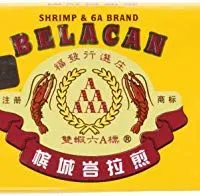


Char Siu Bao Recipe- Chinese Steamed Pork Buns 叉烧包 complete guide
Wednesday 28th of August 2024
[…] you like fried rice, you must not miss the Malay-style fried rice called nasi goreng kampung. Beware, it is spicy […]
Clara
Friday 8th of October 2021
Amazing recipe. Cooked for my English husband last night for dinner and he went on and on about the nasi goreng. Luckily I cooked extra last night and we could have it for lunch today as well (wished we had more though). My husband commented that there was tango dancing in his mouth and full of flavour.
KP Kwan
Saturday 9th of October 2021
Great to know that you and your husband love it. Enjoy!
Zuraidah
Wednesday 28th of April 2021
Tq for the nice recipe of nasi goreng.. Just the one i'm looking for to cook 4 my family.Have a nice day
KP Kwan
Friday 1st of May 2020
Hi, this is KP Kwan. I am happy to see you in this comment area, as you have read through my recipe. I am pleased to reply to any questions and comments as soon as possible.
Kevin Hill
Monday 4th of May 2020
Hello kp Even though the tamarind is optional You not advise how much to use i added 1 tspn to chilli paste Have made a day ahead and will cook tomorrow night 5May Regards